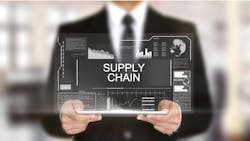If there’s one thing all organizations learned from COVID-19, it’s that their global supply chains are both fragile and vulnerable. With this most recent “shock to the system” continuing to impact supply chains around the globe, now is the perfect time for procurement professionals to start looking at how they can be better prepared for the next disruption, disaster or pandemic.
“The COVID-19 crisis has exposed massive vulnerabilities in the global supply chain,” Michael van Keulen writes in “Weathering COVID: 3 procurement steps to building a resilient business.”
“It has also shed light on the need for organizations to have complete visibility into their business spend and more agility in the procurement process.”
Procurement’s Role in Resilience
Positioned at the forefront of this charge, procurement can help their companies manage through times of uncertainty by taking three steps: investing in the right technology, building strategic relationships with suppliers and focusing on future agility.
“When it comes to supply chain management, many organizations today still have disparate systems that handle the purchasing, receiving, and invoicing of goods,” van Keulen points out. “As a result, they struggle to understand their spend, making it a challenge to build a resilient business during times of uncertainty.”
To solve this problem, he recommends holistically addressing spend under management by investing in cloud-based solutions that incorporate advanced technologies like artificial intelligence (AI) and machine learning (ML).
The second step is to build stronger strategic relationships with suppliers, and it all starts with understanding the health of those suppliers—something that was often overlooked during the 10-year-long economic boom leading up to the COVID-19 pandemic.
“Both the performance and the risk of each supplier can have a significant impact on your company’s spend,” van Keulen writes. “A knee-jerk reaction may be to completely halt company spending and hoard cash until the markets rebound, but that thinking is shortsighted. You still have procurement needs in order to keep your now remote workforce up and running.”
A better approach is to engage thoughtfully and proactively with suppliers while using community data to make smarter, faster decisions. “In doing so, you can quickly tell where you may be exposed to more risk, where operations are business as usual,” he adds, “and where there are opportunities for new short-term contracts to increase organizational agility.”
Early Impacts
Specific to the electronics industry, Forbes says the sector felt early impacts from COVID-19. “The industry’s supply chain is highly dependent on Chinese manufacturers, which account for 90% of the world’s computers and 70% of mobile phones,” IBM’s Bruce Anderson writes in Forbes. “Virtually every electronics product contains Chinese-made components.”
Supply-side impacts diminished as China returned to work, but the global impact on the demand side has been profound—for better and worse. Medical devices, networking gear and anything related to working from home is selling like never before. “On the flip side, demand for automotive components and larger consumer electronics items has all but ground to a halt,” Anderson writes. “Semiconductor and component manufacturing have not seen much impact, but probably will soon.”
Building Resiliency and Flexibility
In his article, Anderson tells companies to set their sights on building resiliency and flexibility for “multiple potential futures,” including a possible second coronavirus wave. “COVID-19 won’t be the last emergency,” he writes. “The next disruption may be a natural phenomenon, a geopolitical issue, or another health crisis.”
Acknowledging that many companies are in survival mode right now, van Keulen says the smartest procurement leaders are training their organizations to remain agile and keep an eye on what happens when the economy recovers.
“With increased transparency into organizational spend and supply chain risk, thanks to cloud technology, organizations can make more informed decisions about the products they buy, the suppliers they work with, and the ways they can simplify their payment processes,” van Keulen concludes. “All of which will better ensure organizational resilience, both in times of crisis and in times of prosperity.”
The good news is that COVID-19 will be defeated and the economy will reopen. Even then, life and business will have to evolve to meet the demands of a changed world. “Electronics companies that take prudent short- and long-term actions now,” Anderson writes, “will be well positioned to emerge from the current crisis stronger and more resilient.”